Transforming your outdoor space into a modern, low-maintenance oasis has never been easier with the innovative approach of landscaping the rocks. This timeless design technique combines natural beauty with practicality, making it a favorite for garden enthusiasts and professionals alike. Whether you’re creating a minimalist retreat, enhancing a sloped yard, or adding texture to your flower beds, rocks offer endless possibilities. From decorative boulders to gravel pathways, incorporating rocks into your garden design can elevate its aesthetics while reducing upkeep. In this blog, we’ll explore creative ideas, tips, and benefits of landscaping the rocks for a stunning outdoor transformation.
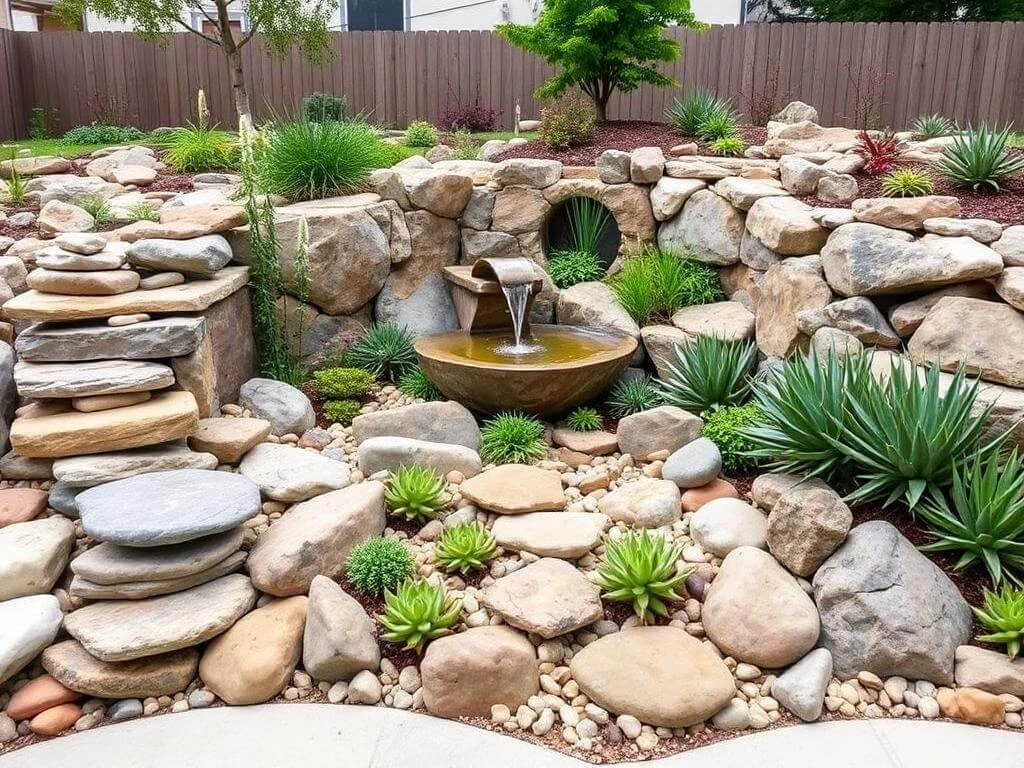
1. The Benefits of Landscaping with Rocks
Landscaping the rocks offers a unique blend of aesthetics, functionality, and sustainability, making it a popular choice for modern garden designs. Whether you’re looking to minimize maintenance or create a visually striking outdoor space, incorporating rocks into your landscape can provide numerous advantages. Here are the key benefits of landscaping the rocks:
a. Low-Maintenance and Durability
One of the most significant advantages of landscaping the rocks is its low-maintenance nature. Unlike lawns or flower beds that require constant watering, mowing, and fertilizing, rock landscapes are nearly maintenance-free. Rocks are durable and can withstand harsh weather conditions, from scorching summers to freezing winters, without fading or deteriorating. This makes them an ideal solution for homeowners seeking a long-lasting, hassle-free garden design.
b. Eco-Friendly and Sustainable Options
Incorporating rocks into your garden aligns with eco-friendly landscaping practices. By using rocks instead of grass or water-intensive plants, you can significantly reduce your garden’s water consumption. Rocks also help prevent soil erosion and retain moisture, making them a sustainable choice for drought-prone areas. Choosing locally sourced stones further minimizes your environmental footprint, ensuring a greener approach to gardening.
c. Enhancing Aesthetics and Adding Texture
Landscaping the rocks allows you to play with different textures, colors, and sizes to create a visually stunning garden. From smooth river pebbles to rugged boulders, rocks bring a natural and timeless beauty to your outdoor space. They can be used to highlight focal points, such as pathways, water features, or sculptures, while seamlessly blending with plants and other garden elements. The versatility of rocks makes them suitable for any garden style, from modern minimalist to rustic cottage.
d. Reducing Water Usage in Drought-Prone Areas
Water conservation is a crucial aspect of modern gardening, especially in regions facing water scarcity. Landscaping the rocks is a practical solution for creating a beautiful garden while significantly reducing water usage. Rock gardens can be paired with drought-resistant plants, such as succulents or ornamental grasses, to maintain greenery without excessive irrigation. This not only lowers your water bills but also contributes to sustainable living practices.
By embracing landscaping the rocks, you can enjoy a garden that’s not only breathtaking but also easy to maintain and environmentally friendly. The benefits go beyond aesthetics, offering a practical and long-lasting solution for outdoor spaces of all sizes.
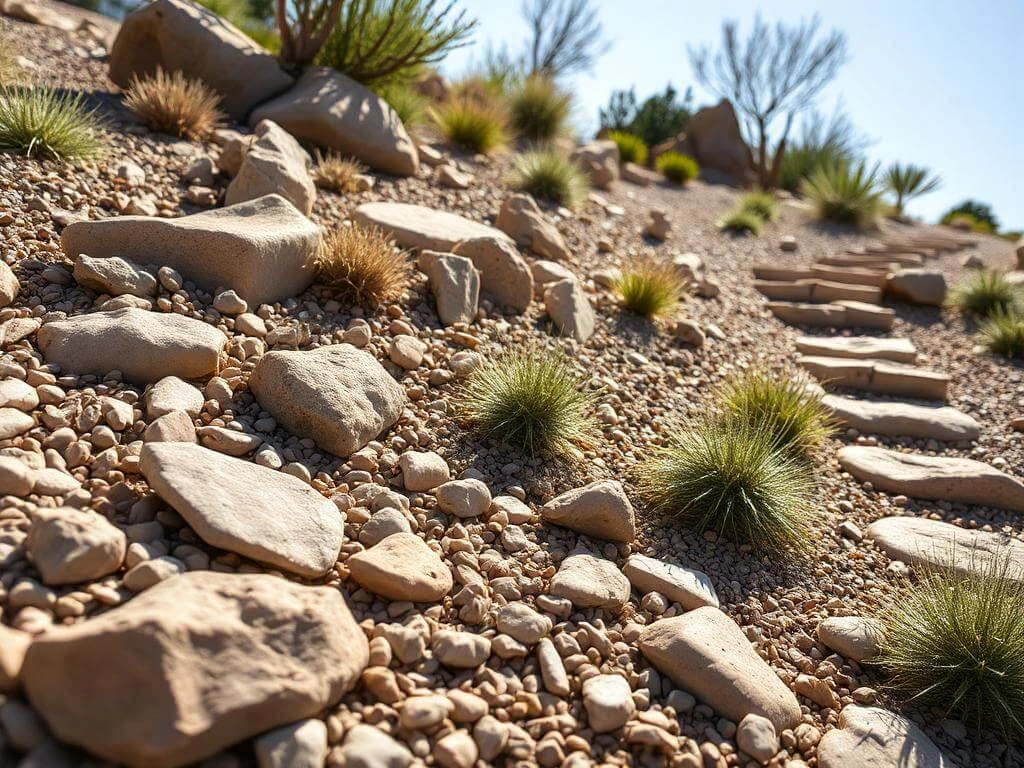
2. Choosing the Right Rocks for Your Garden
Selecting the right rocks is a crucial step in creating a stunning and functional landscape. The rocks you choose will define the overall look, feel, and durability of your garden design. Whether you’re going for a minimalist modern aesthetic or a rustic, natural vibe, landscaping the rocks with the right materials ensures a cohesive and appealing result. Here’s how to make the best choices for your garden:
a. Types of Rocks to Consider
When it comes to landscaping the rocks, understanding the different types available is key:
- Granite: Known for its strength and variety of colors, granite works well for pathways and decorative boulders.
- Limestone: With its softer texture and earthy tones, limestone is perfect for garden edging and retaining walls.
- Sandstone: Its natural, warm hues make sandstone ideal for patios and garden seating areas.
- River Rocks: Smooth and rounded, these are great for water features and creating soft, organic lines in your design.
- Gravel and Pebbles: These smaller rocks are perfect for filling spaces between larger stones or creating pathways.
Each type offers unique characteristics, so choose rocks that complement your garden’s style and purpose.
b. Factors to Keep in Mind: Size, Color, and Texture
- Size: Large boulders create dramatic focal points, while smaller stones add subtle detail. Mix sizes to add depth and dimension to your landscape.
- Color: Opt for colors that harmonize with your home and surrounding environment. Neutral tones work well for modern designs, while earthy hues suit naturalistic landscapes.
- Texture: Smooth rocks offer a polished, contemporary look, while rough stones lend a rustic, rugged charm.
Balancing these factors ensures your rock landscaping enhances the overall garden aesthetic.
c. Sourcing Sustainable and Local Materials
Choosing sustainable and locally sourced rocks not only supports the environment but also reduces costs. Local materials tend to blend better with the native landscape and are often more affordable. Visit local quarries, stone suppliers, or garden centers to explore options that align with your vision for landscaping the rocks.
Additionally, consider repurposing stones from nearby construction sites or using recycled materials for an eco-conscious approach.
d. Mixing Rocks with Other Natural Elements
Rocks can shine on their own, but they work even better when paired with complementary natural elements.
- Wood: Combine rocks with wooden accents like garden benches, pergolas, or borders for a balanced and warm design.
- Water: Enhance the appeal of your rock landscape with fountains, small ponds, or dry riverbeds.
- Plants: Use hardy plants like succulents, ornamental grasses, or alpine flowers to soften the look of the rocks and add a touch of greenery.
By carefully selecting the right rocks and integrating them thoughtfully into your garden design, you’ll master the art of landscaping the rocks to create a modern, beautiful, and sustainable outdoor space.
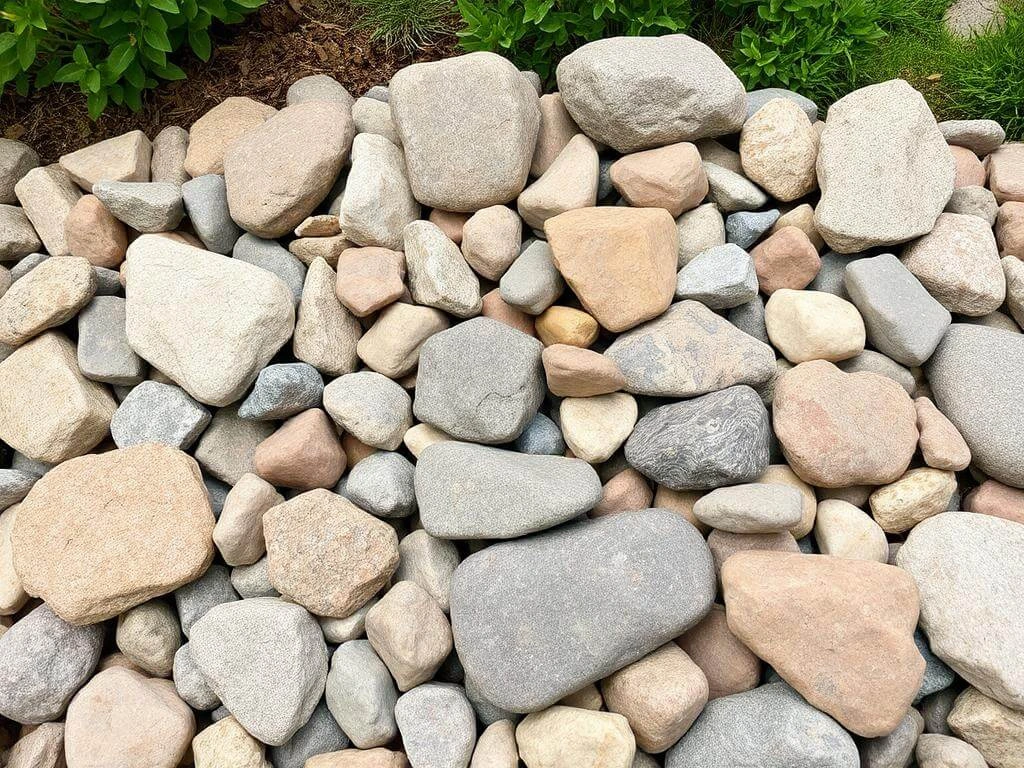
3. Creative Ideas for Landscaping The Rocks
When it comes to garden design, landscaping the rocks offers endless opportunities to unleash your creativity. From bold statement pieces to subtle enhancements, rocks can transform your outdoor space into a modern and visually stunning haven. Here are some inspiring ideas to incorporate rocks creatively into your landscape:
a. Designing Rock Pathways and Stepping Stones
Pathways and stepping stones are practical and stylish ways to use rocks in your garden.
- Pathways: Use gravel or flat stones like flagstone or slate to create durable, low-maintenance garden paths. These paths can lead to focal points like seating areas or flower beds while adding a natural flow to your outdoor space.
- Stepping Stones: Place smooth, flat rocks strategically to create charming stepping stones through grassy areas or between flower beds. This adds functionality while preserving the garden’s natural look.
- Patterned Paths: Experiment with creative patterns like mosaics or geometric designs using smaller rocks or pebbles for a unique and artistic touch.
b. Building Rock Walls for Structure and Style
Rock walls serve both functional and aesthetic purposes in landscaping the rocks.
- Retaining Walls: Use stacked stones to create retaining walls that prevent soil erosion and add depth to sloped gardens.
- Decorative Walls: Build low, decorative rock walls to outline flower beds or garden borders. Incorporate mixed stone textures for a dynamic appearance.
- Seating Walls: Construct a rock wall that doubles as a seating area, providing a cozy spot to relax and admire your garden.
c. Incorporating Decorative Boulders and Sculptures
Large decorative rocks and sculptures can act as eye-catching focal points in your garden.
- Boulders: Place a single large boulder as a centerpiece or arrange several smaller ones for a more natural look. These can anchor the design and draw attention to key areas of your garden.
- Rock Sculptures: Use stacked rocks or carved stone sculptures to add an artistic flair. These can range from simple cairns to intricate designs that reflect your personal style.
- Zen Gardens: For a minimalist approach, create a Zen-inspired space with carefully arranged rocks and raked gravel, emphasizing simplicity and tranquility.
d. Layering Rocks for Terraced or Sloped Gardens
If your garden includes uneven terrain, landscaping the rocks can help you make the most of it.
- Terraces: Use rocks to build terraced levels that create distinct planting zones. This not only adds structure but also makes it easier to manage water drainage and soil retention.
- Rock Layers: Arrange rocks in layers to create a cascading effect, mimicking natural geological formations. This technique works well when paired with lush plants like ferns or groundcovers.
- Waterfall Features: Integrate a small waterfall or stream running through the terraced rocks for a dynamic and calming effect.
By embracing these creative ideas, you can elevate your garden design with the versatility and timeless beauty of rocks. Whether you’re constructing pathways, building walls, or incorporating bold focal points, landscaping the rocks ensures your outdoor space stands out with modern elegance and natural charm.
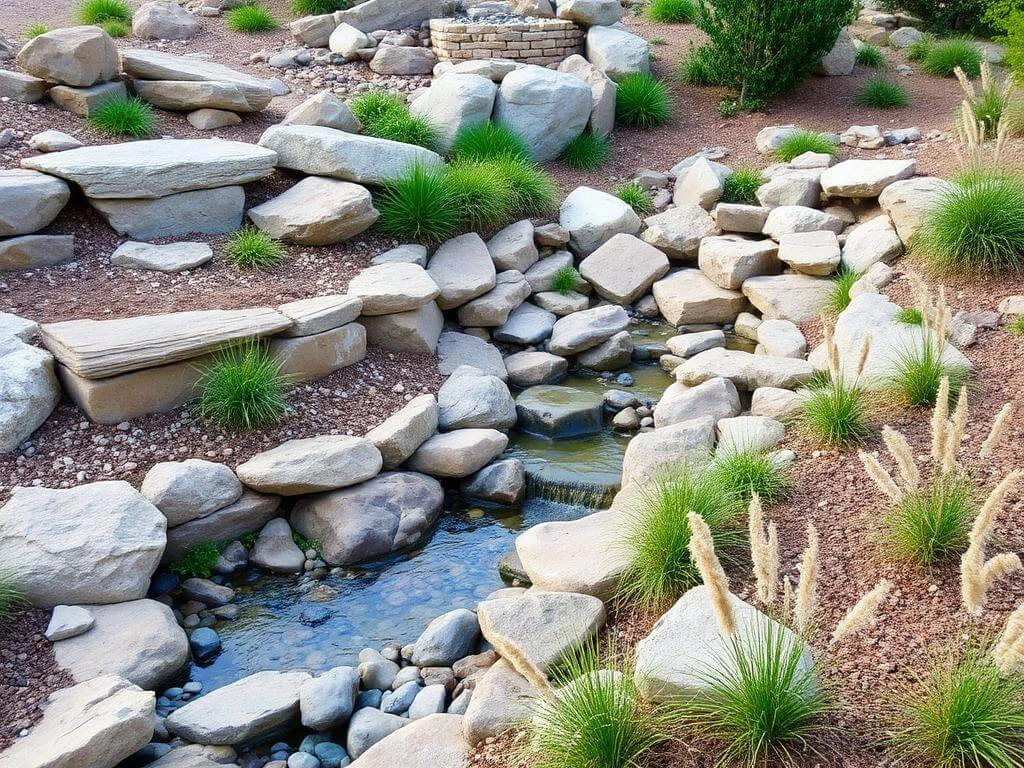
4. Plants and Accessories for Rock Gardens
Integrating plants and accessories into your rock garden can enhance its beauty, balance its rugged appeal, and create a harmonious outdoor space. The right plants and thoughtful decorative touches bring life and vibrancy to your design, complementing the timeless charm of landscaping the rocks. Here’s how you can thoughtfully pair plants and accessories to elevate your rock garden:
a. Best Plants for Rock Gardens
When choosing plants for your rock garden, prioritize species that thrive in well-drained soil and can withstand the heat reflected by rocks.
- Succulents: Succulents like sedum, echeveria, and hens-and-chicks are perfect for rock gardens. Their low water requirements and unique shapes make them a natural choice for arid landscapes.
- Alpine Plants: Hardy alpine plants such as creeping thyme, dianthus, and rock cress thrive in rocky environments, adding splashes of color and softness to your design.
- Ornamental Grasses: Add movement and texture with ornamental grasses like blue fescue or fountain grass. These plants contrast beautifully with the solidity of rocks.
- Native Plants: Incorporate native species that are well-adapted to your region’s climate and soil conditions for a sustainable and low-maintenance garden.
b. Adding Water Features
Water features can add a dynamic element to your rock garden, creating a peaceful and inviting atmosphere.
- Fountains: Place a stone fountain as a centerpiece to bring movement and sound to your garden. Choose designs that blend seamlessly with your rock theme.
- Ponds: Surround small ponds with rocks to create a naturalistic look. Include aquatic plants like water lilies or cattails for added interest.
- Dry Riverbeds: For a unique twist, design a dry riverbed using gravel and smooth stones to mimic the appearance of a flowing stream.
c. Using Gravel and Pebbles for Filler and Contrast
Gravel and pebbles are essential components of landscaping the rocks, adding texture and filling gaps between larger stones.
- Pathway Fillers: Use gravel or crushed stone to fill spaces between stepping stones, creating defined paths and reducing weed growth.
- Contrasting Colors: Mix light and dark-colored pebbles to highlight specific areas or create intricate patterns. This can add visual depth and variety to your garden.
- Drainage Layers: Gravel is not only decorative but also functional, aiding in drainage and preventing water pooling around plants.
d. Lighting Tips to Enhance the Beauty of Rock Landscapes
Proper lighting can transform your rock garden into a magical space, especially in the evening.
- Path Lights: Install solar-powered path lights along rock pathways to ensure safety and highlight the garden’s layout.
- Uplighting: Use spotlights to illuminate large decorative rocks, boulders, or plants, emphasizing their textures and forms.
- Accent Lighting: Add subtle lighting under water features or around focal points to create a serene ambiance.
By combining the right plants and accessories with the natural elegance of landscaping the rocks, you can create a rock garden that’s both practical and visually captivating. Whether you’re going for a minimalist desert aesthetic or a lush, nature-inspired retreat, thoughtful plant selection and creative accessorizing will bring your vision to life.
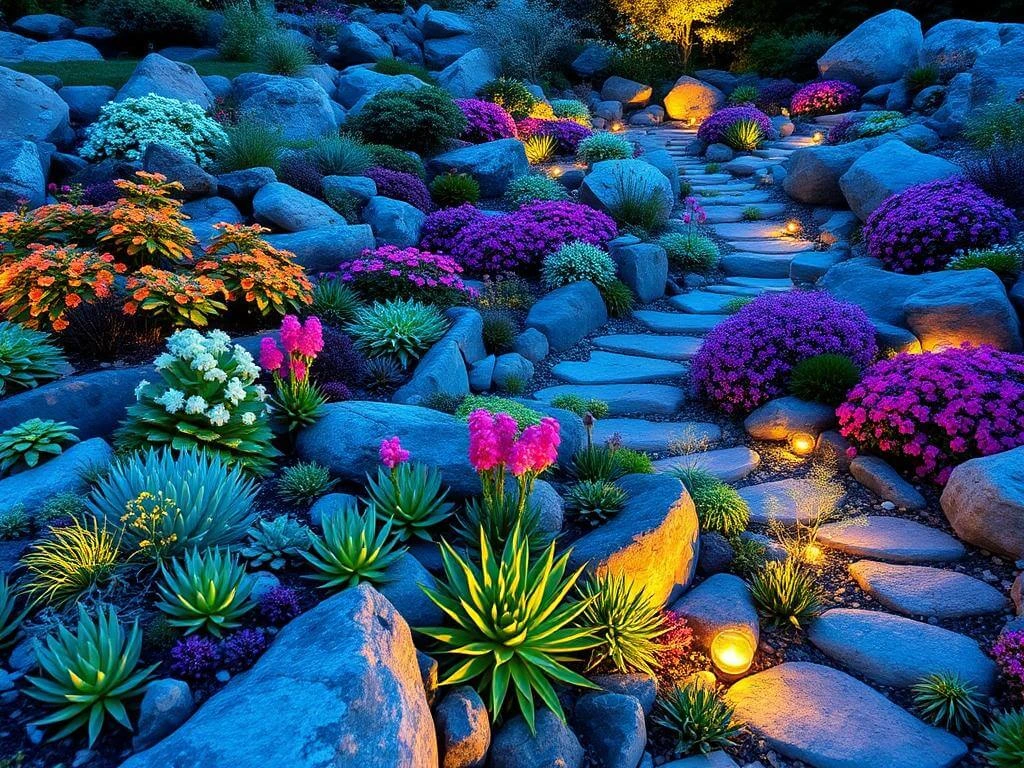
5. Tips for Maintaining a Rock Landscape
A well-designed rock landscape is not only beautiful but also relatively low-maintenance compared to traditional gardens. However, keeping your garden looking pristine and functional requires some effort and care. By following these essential tips for maintaining your design, you can preserve the charm and longevity of landscaping the rocks while ensuring your outdoor space continues to thrive.
a. Regular Cleaning of Rocks and Surfaces
Over time, dirt, debris, and algae can accumulate on rocks, dulling their natural beauty.
- Wash Rocks Periodically: Use a garden hose or pressure washer to remove dust, dirt, and stains from your rocks. Be gentle with smaller stones to avoid dislodging them.
- Remove Algae and Moss: Scrub larger rocks with a mixture of water and mild soap or vinegar to eliminate algae or moss growth, which can make surfaces slippery.
- Clear Debris: Regularly sweep away fallen leaves, twigs, and other organic matter to maintain a tidy appearance.
b. Controlling Weeds and Unwanted Plants
Weeds can disrupt the clean and organized look of a rock landscape. Effective weed control ensures that landscaping the rocks remains neat and visually appealing.
- Use Weed Barriers: Lay landscape fabric or plastic sheeting under gravel and larger rocks to prevent weed growth.
- Apply Mulch: Spread a thin layer of mulch between rocks and plants to suppress weeds and retain soil moisture.
- Manual Removal: Check for weeds regularly and pull them out by hand to stop them from spreading.
c. Ensuring Proper Drainage and Soil Health
Good drainage is crucial for the health of your plants and the stability of your rock landscape.
- Check Drainage Systems: Ensure pathways and areas with gravel or smaller stones have adequate drainage to prevent water pooling.
- Aerate Soil: Around plants, periodically loosen the soil to improve aeration and nutrient absorption.
- Replenish Gravel: Over time, gravel may shift or settle. Add fresh layers as needed to maintain even surfaces and proper drainage.
d. Managing Plant Growth in Rock Gardens
Plants are a vital element of a rock landscape, but their growth must be carefully managed to maintain balance and aesthetics.
- Prune Regularly: Trim overgrown plants and remove dead foliage to keep the garden looking fresh and tidy.
- Fertilize Thoughtfully: Use slow-release fertilizers suited for your plant types to avoid excessive growth that overwhelms the rocks.
- Replant as Needed: Replace plants that outgrow their space or fail to thrive to maintain the garden’s design harmony.
e. Preventing Erosion and Rock Displacement
Erosion and rock displacement can compromise the structure and appearance of your landscape.
- Secure Rocks: Use landscape adhesive or stabilize large rocks in the soil to prevent shifting.
- Combat Erosion: Plant groundcovers or add retaining walls in sloped areas to prevent soil erosion.
- Inspect After Weather Events: Check your rock landscape for damage or displacement after heavy rains or strong winds and make repairs as needed.
f. Seasonal Maintenance Tips
Seasonal changes can impact the condition of your rock landscape.
- Spring: Clear debris, refresh gravel, and prepare plants for the growing season.
- Summer: Monitor plant hydration, ensure proper drainage, and remove weeds frequently.
- Fall: Remove fallen leaves and trim plants to prepare the garden for winter.
- Winter: Protect delicate plants with covers and check rocks for frost-related cracks or damage.
By incorporating these maintenance strategies into your routine, you’ll ensure that landscaping the rocks remains a stunning and enduring feature of your outdoor space. Proper care not only preserves the aesthetic appeal of your garden but also enhances its functionality and sustainability.
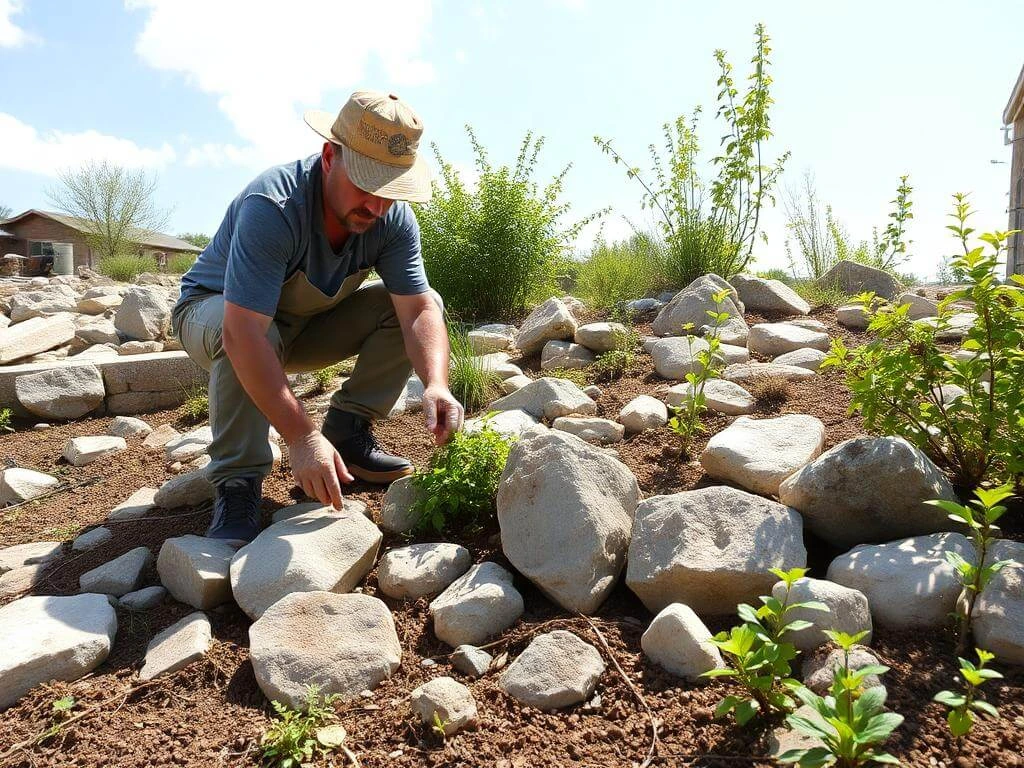
Conclusion
Landscaping the rocks is a modern and versatile approach to garden design that blends natural beauty with practicality. Whether you’re building pathways, creating rock walls, or adding vibrant plants and accessories, this method allows you to craft a unique outdoor space that reflects your style while remaining low-maintenance.
From selecting the perfect rocks to incorporating creative ideas like decorative boulders, water features, and layered designs, rock landscaping offers endless possibilities. By choosing the right plants, enhancing the design with thoughtful accessories, and implementing effective maintenance practices, you can ensure your rock landscape remains beautiful and functional year-round.
Embrace the timeless appeal of landscaping the rocks to transform your garden into a serene and stylish retreat. With its durability, sustainability, and modern aesthetic, a rock landscape is not just a garden—it’s a work of art that will stand the test of time. Start your journey today and discover the endless potential of this innovative gardening approach!
